A Visit to Meadowlark Audio
| Road Trip |
| Clement Perry |
| 19 December 2002 |
Watertown, NY, three hundred forty miles north of New York City and only a stones throw from the Canadian border, is a town so peaceful in its people and so serene in its surroundings, compared to New York City; it’s the real Mayberry RFD. In fact, each mile north via Interstate 81, felt like a step back in time…and seasons, literally. November may only be fall in New York but it’s a snowy blustery winter in Watertown. The snow greeted me about halfway up making driving conditions a serious concern on some roads even for all-wheel drive vehicles like my huge Ford Expedition. Make no mistake about it; Watertown is ski country, and good ski country I hear. I can now see why. The one guy I’m certain who loves early winters and isn’t fazed by ten-foot snowdrifts is Watertown’s own Stu McCreary.
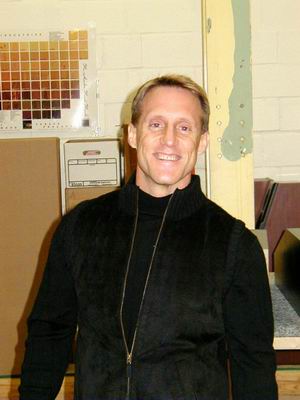
Hadn’t seen Stu in a month of Sundays and I personally didn’t recognize him with all the weight he lost and replaced with muscle bulk. Talk about fit & trim. Damnnnnn! I workout too, well, I mean, I used to, or thought I did. But after one good look at Stu, I’m hitting the floor each morning getting my fifty pushups (thanks for the inspiration). Macho-ness aside, Stu and I really enjoyed the time just sitting in his listening room shootin’ the breeze and of course, listening to music. Stu’s system is sounding very good these days (Stu turned me on the Bel Canto eVo’s) with the new Kestrel2’s burning in. I brought some of my own discs and can tell you that Stu had a damn good system the last time I visited three years ago. Well, he’s not missed a beat and the system is sounding just as good if not better, considering the last time I was there the $12,500 Von Schweikert VR6 loudspeakers were in-house. Well, if the Kestrel2’s are a third that price and sound as good as I heard with my own CD’s, then I’ll bet you the Kestrel2’s become Stu’s reference. Unless he takes a deep breath and opts for the Blue Heron’s.
My purpose in visiting Watertown was not just to hang out with Stu listening to music, as pleasant as that was. My goal was to see the new facility of Watertown’s newest denizen Pat McGinty, Meadowlark Audio’s chief engineer and designer.
Originally from New York, McGinty, believe it or not, started his cross-country drive to Watertown from southern California on September 11, 2001. This obviously made the drive very intense for McGinty and his wife Lucinda. For one, on that fateful day, all aircraft were grounded within forty-five minutes-an aviation first-after the attacks. Excepting fighter jets screaming across the horizon our skies were painfully silent.
Despite the long and sometimes scary drive east, the McGinty’s arrived safely in Watertown, thankfully, in one piece. Despite the fears the swept across our nation, the McGinty’s, amazingly I should add, got busy getting their plant readied to build loudspeakers. So busy, in fact, McGinty redesigned virtually ALL of his loudspeakers within one year. By the looks of the accented wood finish on his new Kestrel2’s and Ospreys I would say McGinty was very busy indeed. How busy (you had to ask)? Busier than a one-legged man in an ass-kickin’ contest!
Background Check
Pat McGinty began Meadowlark Audio back in 1995 with the debut of his now classic Kestrel loudspeaker, though he had developed quite a reputation for himself designing loudspeakers dating back to 1987. Seventy percent of Meadowlark owners purchased via word-of-mouth McGinty boasts. I was taken by the Meadowlark sound when I first heard the Ibises at fellow compatriot Leon Rivken’s place. Driven by a pair of VAC Renaissance mono’s, these first-order, phase-coherent, transmission-line behemoths left an indelible imprint on my audio psyche. Of course, it didn’t help with Stu calling me up raving over the little Swifts stating, “They sound too good.” My intrigue, fueled by both Leon and Stu’s enthusiasm, and of course, my own curiosity, led me to Watertown.
My visit left me with this revelation: Pat McGinty is a serious loudspeaker designer. I suspect other loudspeaker designer’s envy him. Also, he and his lovely wife Lucinda are a team. A damn good one too. Hell, they’ve lasted this long and look to be growing as a company despite our lagging economy. If you’ve already met the McGinty’s, or spoken to them on the phone, then you already know what I’m talking about. In this business, which is an unusually tough one, the McGinty’s are widely considered one of high-end audio’s pleasantries. Needless to say, my trip proved to be an eye, and ear, opening one. Hopefully, there will be more on these pages.
Here’s a brief technical description of the Meadowlark approach to loudspeaker design by explained by McGinty.
On Transmission Line bass loading, McGinty says,
“Though excruciatingly difficult to design and quite challenging to construct, the Transmission Line bass loading concept delivers deeper and tighter bass than the simple vented alignments that prevail in the market. A recent realization – an epiphany of sorts – on my part has lead to BASSIC – which stands for IMPEDANCE COUPLED BASS. The Swift was the first model to feature this new concept – and you heard it Clement – it is no joke.”
On Time Coherence, he continues,
“All Meadowlark speakers are time coherent using simple first-order crossovers made with the finest parts and physically phase aligned drivers by virtue of the slanted baffles to achieve coherent output. Clement, as you may know, most speaker companies disregard what we consider to be a minimum performance characteristic – time coherent output. Simply put, this means that the acoustic output of the speaker “looks” like the input signal; the speaker reproduces the waveform that it is ‘fed’ at the input terminals. It often comes as a surprise to audio customers that 98% of speaker companies do not even attempt to reproduce the waveform. But that is the current state of affairs. Meadowlark and a bare handful of others have raised the bar, if you will, by designing and building coherent speakers. FYI – all amplifiers are coherent, so are preamps, CD players, phono cartridges, microphones. Cheap cassette players are coherent. Even the cheapo 79-cent op-amp that you buy at Radio Shack is coherent. The ONLY link in the chain that is “allowed” to be incoherent is the speaker…and the reasons are it’s cheaper, it’s easier and everybody else does it.”
A full workup on the subject – with animations – can be located is available on Meadowlarks website.
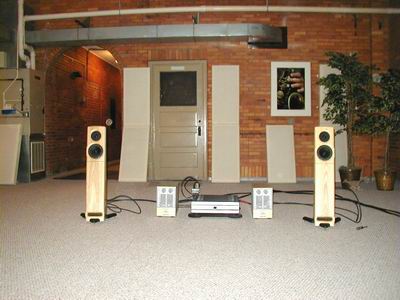
Got to admit McGinty’s right. The sound coming from those little Swifts was quite impressive when driven by Mike Elliott’s Aria 350 mono amplifiers and a BAT preamp. Considering this huge (all-brick) room’s dimensions, which I estimated to be 25 by 60 feet, pulling off a stunt like filling the room with sound would be hard for any loudspeaker, much less the Swift. I mean, c’mon, it retails for only $995.
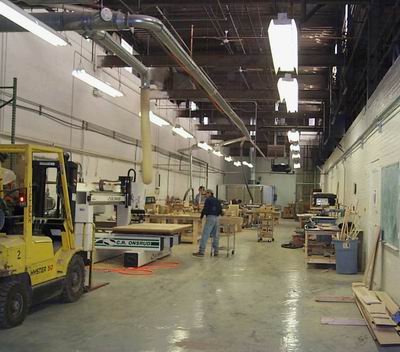
Life for Meadowlark Audio begins here in their new plant. McGinty boasts his production model as
“…quite aggressive, even daring. We are doing a number of things here that just have not been done before. Bottom line is that we are set up for a continuously mixed production environment that can quickly produce both small and large runs of product. The prototype to production process integrated by our CNC methods is remarkably fast. I actually conceived the Swallow, designed it, prototyped it and put it into actual production in less than a week!”
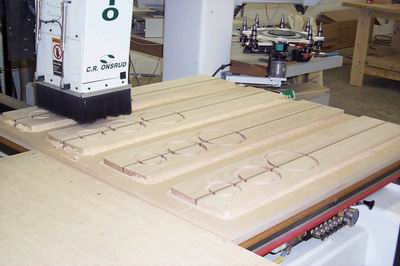
Here’s a shot of McGinty’s powerful CNC Router machining a set of four Osprey baffleboards.
A pair of Swifts on the hand-assembly line. While most speakers are V-grooved and folded together to save cost, Meadowlark’s products are fitted exact with an unusually large joint for maximum gluing area. They are then glued in the traditional fashion, by hand, and clamped for several hours to allow the glue to polymerize. The result, says McGinty,
“is an extra strong joint that is the key to a stabile cabinet.” You’ll notice through the woofer hole on the Swift that is facing you, that the speakers are intensively lined with a heavy acoustic felt that does an superb job of absorbing the backwave.”
(Built on the right is their largest Blue Heron Center Channel).
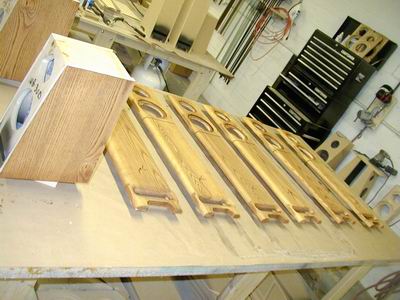
Swallow cabinets and Swift baffleboards with Dark Ash stain applied are ready for lacquering and glue up.
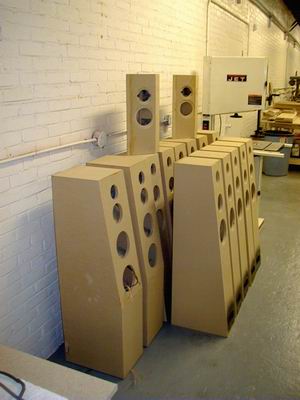
Blue Heron2, Osprey and Owl raw cabinets awaiting application of veneer.
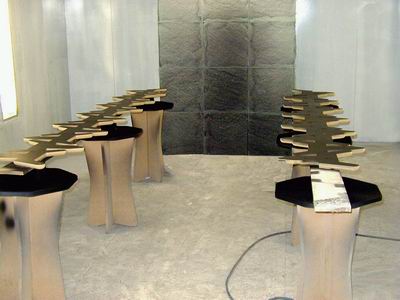
This is a photo of the interior of their spray booth with a bunch of Swift bases partially coated with their black texture finish.
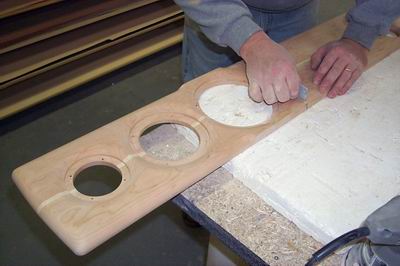
The Osprey’s baffle board being sanded and readied into a Pennsylvania Cherry with a Rock Maple Stringer.
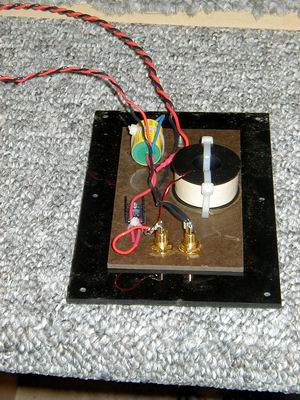
The Meadowlark Audio Swift crossover, built entirely in house using AuriCap capacitors, heatsinked Caddock power resistors and a 16 gauge core inductor with all parts hand point-to-point soldered using silver solder. All Internal wire is DH Labs T-14 silver-plated oxygen free copper in a Teflon dielectric. Frankly, the parts quality is what you’d expect to find in a $10K speaker – if that. As you can see, the crossover is absolutely minimalist – a simple first order electrical design. When in place in the speaker, it resides in its own isolation chamber.
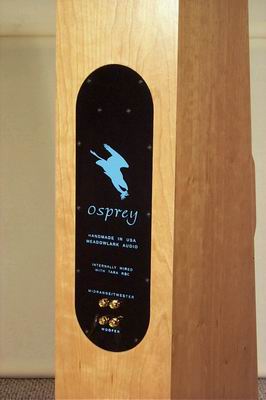
The rear shot of the new Osprey
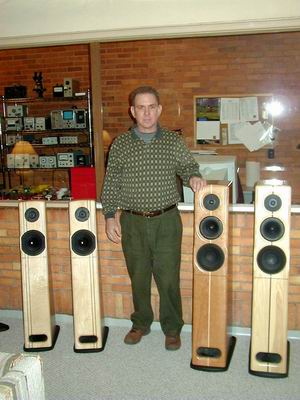
Pat McGinty smiles while sandwiched between his latest arrivals. On the left is a world’s first exclusive photo of the Kestrel2 prototypes done in Curly Maple with twin offset walnut stringers (wood accent). Look for Meadowlark to make a formal announcement in the very near future of there arrival. On the right are the Ospreys done in Pennsylvania Cherry with a Rock Maple Stringer, and Light Native Ash with a Heritage Walnut Stringer. In the rear you can see part of Meadowlark Audio’s lab – which McGinty describes as one of the more extensive analog labs in audio.
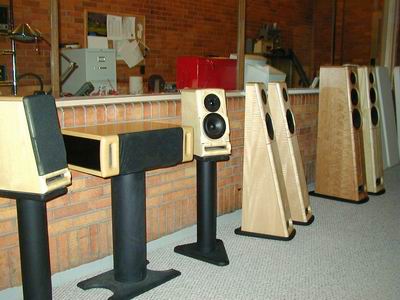
Here’s Meadowlarks Swallow bookshelf speakers flanking the Swan center channel (both in a Light Ash finish). The Swallows are perched on Meadowlark’s new (sand fillable) stands which list for $249. The stand’s appearance looks very basic to the naked eye but McGinty declares “don’t let the looks fool you. They’re sonically excellent owing to the heavy sand damping.” The Kestrel2 prototypes and Ospreys are also visible.
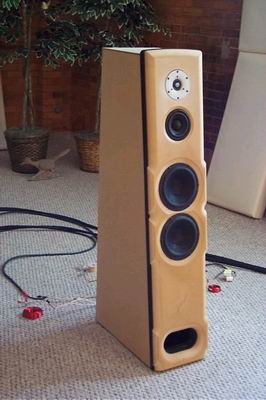
An exclusive world’s first glimpse at the new Blue Heron2! And I’ll be the first to say that I am as impressed by the Heron’s look as I am its sonic performance. Talk about WAF appeal! Priced at $10,000, it looks and sounds much more expensive once you see it up close. The one thing you become instantly aware of at Meadowlark Audio is there’s virtually no difference in how McGinty builds his loudspeakers based on price. As you can see in the photos, they’re built from the very same fabric, perhaps a finer silk thread exists in the Blue Heron, but it’s the same needle pattern.
![]()
Don’t forget to bookmark us! (CTRL-SHFT-D)
Stereo Times Masthead
Publisher/Founder
Clement Perry
Editor
Dave Thomas
Senior Editors
Frank Alles, Mike Girardi, Key Kim, Russell Lichter, Terry London, Moreno Mitchell, Paul Szabady, Bill Wells, Mike Wright, Stephen Yan, and Rob Dockery
Current Contributors
David Abramson, Tim Barrall, Dave Allison, Ron Cook, Lewis Dardick, Dan Secula, Don Shaulis, Greg Simmons, Eric Teh, Greg Voth, Richard Willie, Ed Van Winkle, and Rob Dockery
Music Reviewers:
Carlos Sanchez, John Jonczyk, John Sprung and Russell Lichter
Site Management Clement Perry
Ad Designer: Martin Perry





Be the first to comment on: A Visit to Meadowlark Audio